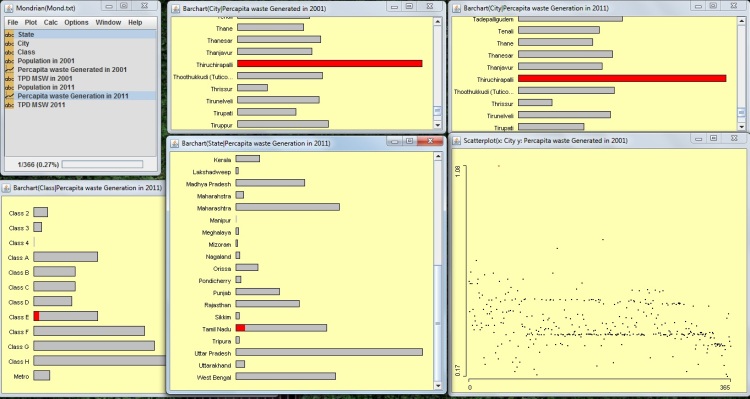
Tiruchirappalli Waste Generation Pattern
In the process of analysing the MSW (Municipal Solid Waste) generation pattern in India, I came across an outlier in the scattered plot. On observing this abnormal behaviour, I created a new excel sheet for Mondrian (just to be sure). The results were the same. I created multiple bar charts for a better behavioural analysis. The charts included waste generation pattern in India (state-wise), City Tiers, MSW (TPD) of Tiruchirappalli in 2001 and MSW (TPD) of Tiruchirappalli in 2011.
On selecting the outlier, the result was confirmed! Tiruchirappalli indeed produced maximum waste in India but what was rather surprising was the fact it was a Class E city with a very small population. This intrigued a question: why? While hunting for the answer I stepped onto many interesting facts associated with this case.
Waste Water Management in Trichy are handled by the state Government board (TWAD) and by the municipal corporation.
Trichy has been a hotspot for industrialization ranging from Distilleries and Chemicals Limited (TDCL), which are major causes of water related concerns, to Cigar manufacturing. The Ordnance Factory Tiruchirappalli (OFT) and Heavy Alloy Penetrator Project (HAPP) are defence establishments located in that region along with other manufacturing units of engineering equipment. It is also a home to Bharat Heavy Electricals Limited (BHEL), India’s largest public sector engineering company.
At last but not the least, the most interesting part is Trichy’s Slum Clearance movement was the real choke in the pipe. When the city slept, an untold and unknown community moved on the streets and cleared of the waste from the street and recycled them in house. Close to 1,200 houses were developed (a few still in the process) in 36 different-slum site. This not only created havoc for the slum dwellers but also piled up the trouble for the city and its waste management.
A strategic plan for slum removal and a stakeholder analysis are very essential components in human and social welfare activities which clearly did not happen as it should have!
Very good use of visual tools to detect outliers!
The more I work with it, the better it gets! Thank you Carlos.